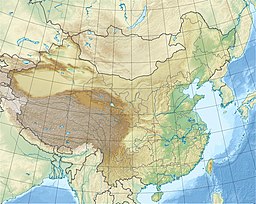
Back بحيرة بويانغ Arabic بحيره بويانج ARZ Llagu Poyang AST Поянху Bashkir Паянху Byelorussian Поянху Bulgarian পয়াং হ্রদ Bengali/Bangla Llac Poyang Catalan Pcho-jang-chu Czech Поянху CV
You can help expand this article with text translated from the corresponding article in Chinese. (November 2019) Click [show] for important translation instructions.
|
| Poyang Lake | |
|---|---|
 Satellite image of Lake Poyang | |
| Location | Jiujiang, China |
| Coordinates | 29°05′N 116°17′E / 29.083°N 116.283°E[1] |
| Primary inflows | 5 rivers, primarily the Gan and Xiu |
| Catchment area | 162,225 square kilometers (62,635 sq mi)[2] |
| Basin countries | China |
| Max. length | 170 kilometers (110 mi) |
| Max. width | 17 kilometers (11 mi) |
| Surface area | 3,210 square kilometers (1,240 sq mi)[1] |
| Average depth | 8.4 meters (28 ft)[1] |
| Max. depth | 25.1 meters (82 ft)[1] |
| Water volume | 25.2 cubic kilometers (6.0 cu mi)[1] |
| Residence time | 0.173 years[1] |
| Shore length1 | 1,200 kilometers (750 mi)[1] |
| Surface elevation | 16.5 meters (54 ft)[1] |
| Official name | Poyanghu |
| Designated | 31 March 1992 |
| Reference no. | 550[3] |
| 1 Shore length is not a well-defined measure. | |
Poyang Lake (traditional Chinese: 鄱陽湖; simplified Chinese: 鄱阳湖; pinyin: Póyáng Hú, Gan: Po-yong U), located in Jiujiang, is the largest freshwater lake in China.[4]
The lake is fed by the Gan, Xin, and Xiu rivers, which connect to the Yangtze through a channel.
The area of Poyang Lake fluctuates dramatically between the wet and dry seasons, but in recent years the size of the lake has been decreasing overall. In a normal year the area of the lake averages 3,500 square kilometers (1,400 sq mi). In early 2012, drought, sand quarrying, and the practice of storing water at the Three Gorges Dam lowered the area of the lake to about 200 square kilometers (77 sq mi).[5] The lake provides a habitat for half a million migratory birds[6] and is a favorite destination for birding.
During the winter, the lake becomes home to many migrating Siberian cranes, up to 90% of which spend the winter there.
- ^ a b c d e f g h "Poyang Lake". World Lake Database. International Lake Environment Committee Foundation. 1999. Retrieved 6 January 2017.
- ^ Ding, Duowen; Tan, Xueqing (2011). "Numerical Simulation of the Effects of the Urbanization on the Poyang Wetland". In Kenneth W. Potter, Donald K. Frevert (ed.). Watershed Management 2010. American Society of Civil Engineers. p. 444. ISBN 978-0-7844-1143-8.
- ^ "Poyanghu". Ramsar Sites Information Service. Retrieved 25 April 2018.
- ^ http://english.people.com.cn/200202/21/eng20020221_90777.shtml People's Daily Online "Spring Fishing Ban on China's Largest Freshwater Lake"
- ^ Thibault, Harold (31 January 2012). "China's largest freshwater lake dries up". The Guardian. ISSN 0261-3077. Retrieved 9 November 2016.
- ^ Detailed Data Lake Poyang-hu. Global Nature Fund.
© MMXXIII Rich X Search. We shall prevail. All rights reserved. Rich X Search
